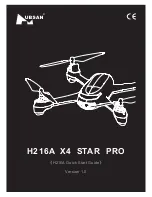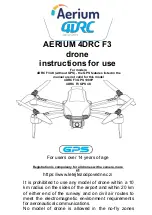
4
M5
M6
M4
M3
M2
M1
5
4
3
2
5.8G ghz video down link
Auto Take off
Altitude hold mode
Object Round fly mode
One key Return To Home
Hyper IOC mode
Retractable Landing Gear
GPS telemetry
Quick Start Guide and Systems Flowchart
Match with DEVO F12E
Specifications:
Main Rotor Dia. : 233mm
Overall (L x W x H): 471 x 536 x 270mm
Takeoff Weight: <2500g
Weight: 2020g(Battery included)
Transmitter: DEVO F12E
Brushless Motor: WK-WS-34-001
Brushless ESC: WST-15AH (R/G)
Main Controller: FCS-H500
Battery: 22.2V 5400mAh Li-Po
Receiver: DEVO-RX705
M1/M3/M5 rotate in counterclockwise, motors are the dextrogyrate thread.
M2/M4/M6 rotate in clockwise, motors are the levogyrate thread.
1
Installing the Propellers
Installing Battery, Binding the radio, and extending the landing gear.
Power switch
Power button
Power indicator
Compass Calibration
Ground
Head vertical down
G-3D 3-axis brushless Gimbal installation
Installing the iLook+ 1080p camera with 5.8ghz video link
1.1 Unpack the propellers, there are two kind
right-hand and left hand rotation, the rotation
is identified with arrows on the prop, and also
with the colored prop-top. You need 3 of each kind.
*We recommend balancing the propellers.
Check online for balancing instructions.
1.2 Match the arrows on the propellers to the
arrows on the arm next to each motor. Screw
each propeller onto the motor, secure by hand,
no need for tools.
1.3 After installing the props, check each
propeller carefully.
Before EACH flight, Inspect propellers
for damage.
The Landing gear is shipped in the retracted position.
DO NOT try to extend the landing gear by pulling on it.
We will deploy the landing-gear the first time the system is powered, please follow these instructions carefully.
2.1 Install the fully charged battery
DO NOT turn on the battery until later.
*Please check the charger manual for
charging instructions
2.2 Turn TALI on its back. The belly and the
retractable legs should now be facing up.
MAKE SURE nothing is blocking the legs.
2.3 On the DEVO F12E, move ALL
switches to the “0” position, and move
the throttle to the lowest position.
Then turn on the DEVO F12E power.
2.4 Slide the power-switch to the ON position
then press on the triangle power button
for about 3-5 seconds, until the green
Power indicator lights up.
* The Landing gear will now unfold automatically.
* In the beginning of this process the light in the
arms flast red-green, this means the system is binding.
2.5 Turn the aircraft to its UP-right position.
The Red-Green LED flashing will stop shortly.
When it stops, the DEVO F12E and the H500 have
successfully connected to each other.
* This process is called “ID binding”
2.6 After the successful binding
place the aircraft on a stable surface.
IMPORTANT:
Make sure all TRIMs are in the center position, the trim value should be “0”, and that the motors are locked.
The aircraft should NOT be flashing RED-GREEN. By default, the motors will automatically be locked after the ID binding process.
For more details about locking and unlocking motors, see points 6 & 7.
3.1 Enter the calibration mode
Do this by moving both sticks DOWN and
to the middle position at the same time.
The aircraft will start a blinking fast RED-GREEN
3.2 FORWARD rotation Rotate tilting the aircraft
forward rotate smoothly in 90 deg increments.
Pausing 1 second for each 90 deg.
(0 / 90 / 180 / 270 / 360)
3.3 CLOCKWISE rotation Rotate the
aircraft around the roll axis rotate smoothly
in 90 deg increments. Pausing 1 second
for each 90 deg. (0 / 90 / 180 / 270 / 360)
3.4 HORISONTAL rotation Rotate the aircraft
around the YAW axis rotate smoothly in 90 deg
increments. Pausing 1 second for each 90 deg.
(0 / 90 / 180 / 270 / 360)
3.5 NOSE DOWN rotation Rotate the aircraft
facing the nose down. rotate smoothly in 90 deg
increments. Pausing 1 second for each 90 deg.
(0 / 90 / 180 / 270 / 360)
3.6 Place the aircraft in normal position
The rapid RED-GREEN blinking will stop
This indicate that the calibration is finished
Disconnect the battery to save the settings.
IMPORTANT: The first couple of flights, you may expereince the aircraft drifting,
This is normal, please continue to fly the aircraft manually, while the system inprove the calibration,
after 5-10 minutes land, lock the motors, this will save the improved settings.
Notice: The slight drifting may continue for a couple of batteries, you will notice significant improvement in the GPShold & stability after 4-5 batteries.
Notice: Always perform the calibration away from eletric fields and metal surfaces.
Trivia: Different brands have different calibration processes, the process is typically refered to as “the Calibration Dance”.
IMPORTANT:
REMOVE the battery from the H500 while you install the gimbal
The gimbal is a high-performance eletromechanical design and should be handled with great care. AVOID using force when installing.
4.1 Unpack the G-3D gimbal,
prepare the gimbal, the mounting
rail, rubber washer, screws and spring
loaded screw.
4.2 Put the rubber washer on the threaded hole on
the bottom of the H500, use the M3x8mm and
M3x10mm screws to install the gimbal “mounting
block” also refered to as the quick mount rail.
4.3 Slide the gimbal unto the quik mount
rail, the gimbal shouldslide from the front
of the aircraft towards the rear, gently
move it as far back as possible.
4.4 Install the springloaded
M3x12mm “finger screw” at the front
of the gimbal, this will secure the gimbal.
4.5 Connect the 9pin white data cable to the “complex
data port” on the bottom of the TALI, then connect the
cable to the back of the G-3D gimbal.
4.6 Make sure the gimbal move freely
in all directions. The G-3D gimbal is
now successfully installed.
IMPORTANT:
NEVER POWER the iLook+ camera without the antenna installed.
Powering a video transmitter may cause damage to the transmitter.
5.1 Screw the short “mushroom” antenna
into the camera, use the included wrench
to gently secure the antenna, do not use force.
5.2 Release the two M2x4 screws securing the
camera mounting bracket.
5.3 Position the camera into the gimbal
“tray”, then secure the camera by
positioning the mounting bracket over
the camera, use the two M2x4mm
screws to secure the mounting bracket.
* There is a cutout on the mounting
bracket, this will fit around the lens.
** It is also possible to install a GoPro3
camera in this gimbal. IF you install a
GoPro, unscrew and remove the motor
cover on the pitch motor, this will adjust
the balance of the gimbal for the GoPro.
*** Use the switch on the end of the
iLook+ camera to select between
STILL and 1080p video.
**** You can change the video link
frequency on the back of the camera,
see the instructions included with
the camera for details on camera
operation.
5.4 Connect the cameras power
cable to the power port on the
G-3D gimbal controller.
5.5 The iLook+ camera is now successfully
installed in your G-3D gimbal.




















